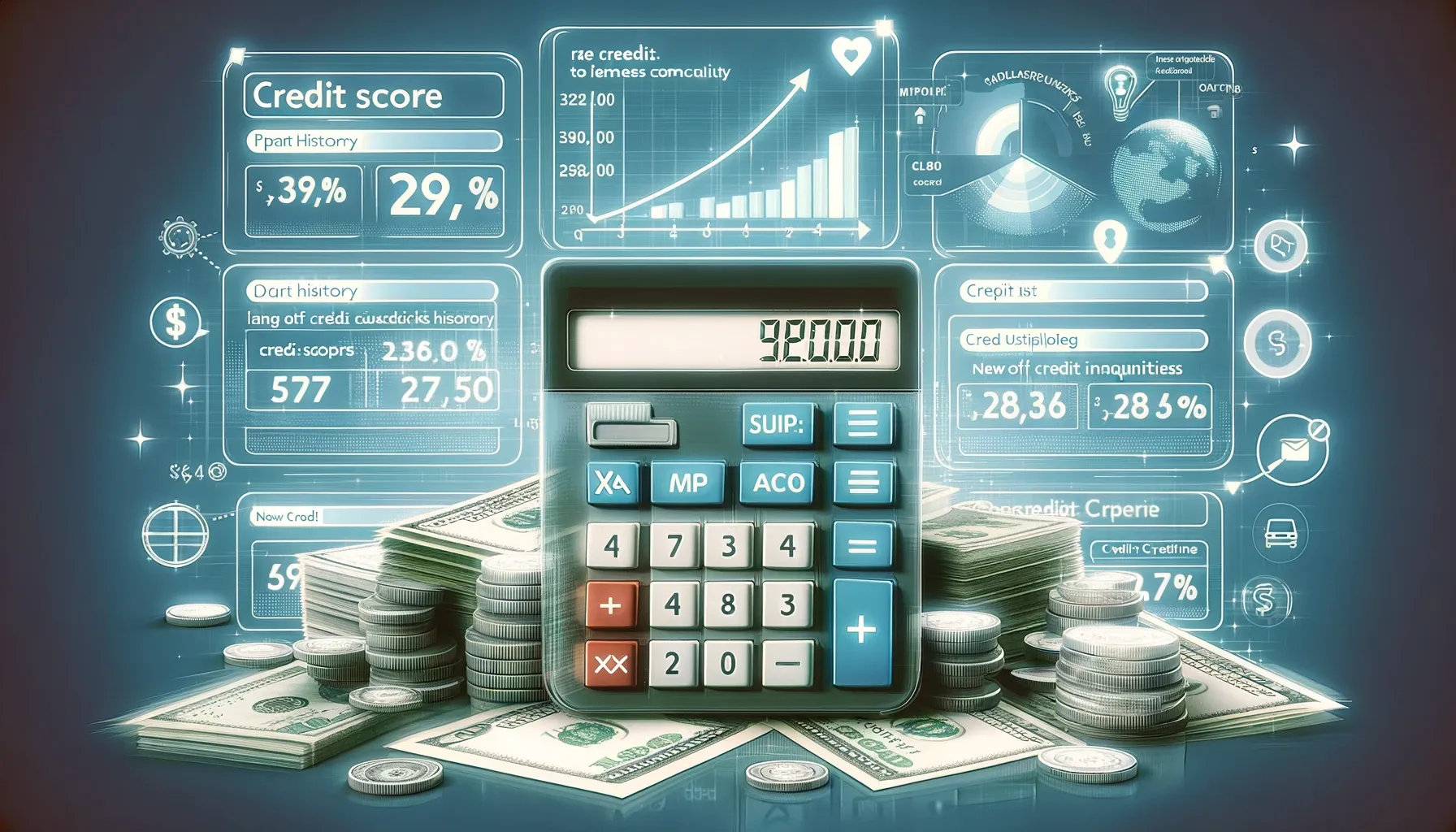Boost Your Credit Score in 30 Days: Action Plan for Days 8-14

Improving your credit score within a month is not only achievable but also crucial for your financial health!
As a former banker, this week I'm going to give you my absolute favorite and quickest method to increase your credit score fast. You'll love it! It's easy, simple and most importantly quick. You'll consistently use it after you learn it.
Whether you're looking to secure a better interest rate on a loan or mortgage, qualify for a new credit card, or simply want to enhance your overall financial well-being, taking steps to raise your credit score can have a profound impact on your financial future.
If you need to obtain your credit report or view week 1's action steps, go to Boost Your Credit Score in 30 Days: Action Plan for Days 1-7. Otherwise continue to read.
Week 2: Boost Your Score
In this article, we will provide you with valuable credit score improvement tips to help you see tangible results within 30 days.
In week 2, you will learn how to apply for credit sparingly, limit new credit inquiries, increase your credit limit, keep balances low on credit cards, keep unused credit card accounts open, become an authorized user on a credit card, and negotiate lower interest rates. These strategies are designed to provide a quick boost to your credit score and set you on the path to improving your credit health.
Day 8: Apply for Credit Sparingly to Boost Your Credit Score in 30 Days
On Day 8, be mindful of your credit application activity. Each time you apply for new credit, such as a credit card or a loan, it can result in a hard inquiry on your credit report, which might lower your credit score.
Hard inquiries negatively impact your credit score, typically lasting about two years. To avoid unnecessarily lowering your score, be cautious about applying for new credit during these 30 days.
Because of this, I'm selective about the loans and credit cards I apply for. I can't count the number of times I've been in a store paying for my merchandise and the cashier says, "You can get 15% off your purchase today if you apply for our store credit card. Would you like to complete an application? It only takes two minutes to apply.
Watch out for in-store credit card offers and point-of-sale credit card promotions—I certainly do! I have my own guidelines for dealing with these offers.
- If I'm about to spend more than $500, I might consider applying for the card to snag the 15% discount. This discount could save me $75 on a $500 purchase. However, it's only worthwhile if, six months later, I don't increase my debt because of this new card.
- If I was already planning to get the exact credit card the merchant is offering, I seriously think about applying for it.
- If I have no plans to apply for a loan or credit card, buy a car or house using credit, or refinance existing debt, then I might apply for the credit card to receive the discount.
If none of these situations apply to me, then I politely decline the offer with a "No, thank you!" The advantage of turning down the credit card offer is that I won't get deeper into debt with it.
I said all this to say apply for credit sparingly, knowing that each application can cause your credit score to drop. Simply put, if you don't have the card, you can't get into debt with it or because of it.
All in all, I advise applying for credit sparingly, considering that each application can cause your credit score to drop.
Day 9: Bundle New Credit Inquiries
Similar to Day 8, it's important to limit the number of new inquiries into your credit report. If you're shopping for a loan or credit card, do it all within a short time to minimize the impact on your credit score.
Hard inquiries can occur when you apply for new credit, such as a credit card or loan. These inquiries can hurt your credit score.
To avoid lowering your score with too many hard inquiries, it's crucial to be mindful of how many credit applications you submit. When you apply for multiple lines of credit over an extended period of time, each application triggers a separate hard inquiry, which can potentially lower your score further.
The key phrase here is "over an extended period" which indicates that you have a way to submit multiple loan and/or credit card applications while limiting the damage to your credit score.
Here's how I submit multiple credit applications without unnecessarily causing excessive damage to my credit score:
- Like Day 8's advice, I apply for credit as sparingly as I can. In other words, I make a list of the lenders with whom I want to apply.
- Next, I look at the terms, interest rate, and fees and choose the lender(s) I believe will offer me the deal.
- Then I rank them beginning with the best to the worst based on my financial needs and goals.
- Finally, I decide to apply for my top lender. If their approval process is quick, then I only apply for one at a time.
- As soon as I get an approval, I stop submitting applications. Why? Because my goal is not to amass a lot of credit all at once, but just the one card or loan I want.
Hard inquiries occur when a lender reviews your credit report during the evaluation of a new credit application. While a single inquiry may not have a significant impact, multiple inquiries within a short timeframe could raise concerns for lenders.
This could suggest that you're actively seeking credit, potentially signaling higher risk and resulting in a further drop in your credit score. Additionally, multiple inquiries may indicate to lenders that you've been denied credit elsewhere.
As a former banker, I understand that bankers tend to be conservative. When they see numerous inquiries, they often raise two important questions:
- Is the individual accumulating excessive credit, possibly leading to a high debt-to-income ratio?
- Have other financial institutions rejected their application due to undisclosed negative factors? When suspicion arises, bankers may be inclined to reject the application.
What If You Must Submit Multiple Credit Applications?
Consolidate your credit applications within a short timeframe.
For example, if you're looking for a mortgage or car loan, submit all of your applications within a 14 to 30-day window. This approach helps lenders know that you're shopping for the best rates and terms, rather than let them assume you're desperate for credit.
Additionally, if you're dealing with a live representative rather than an automated system, inform each lender that you're actively shopping around. Most lenders will provide their rates and terms upfront, allowing you to make informed decisions before applying.
Lenders typically understand that consumers may apply for multiple credit options when making significant financial decisions. By bundling your applications together, the credit bureaus and scoring models recognize that you're not seeking excessive amounts of new credit, but rather exploring various options to make the best choice.
Remember, each credit inquiry can stay on your credit report for up to two years, but they only impact your score for the first year. The impact of each inquiry will gradually decrease over time.
Bundle multiple credit inquiries within 14 to 30 days by minimizing the number of new inquiries on your credit report, you can protect and preserve your credit score to protect your credit score.
Day 10: Increase Your Credit Limit
Now I'm going to share my absolute favorite method with you!
Requesting a credit limit increase can improve your credit utilization ratio, if you don't increase your outstanding debt balances. By increasing your credit limit, you effectively reduce your credit utilization percentage, which will positively impact your credit score.
When you request a credit limit increase, it's important that you don't use the additional credit for new purchases. The key here is to maintain a low balance relative to your credit limit, as this shows responsible credit management and financial discipline.
In the chart, do you see how the credit utilization ratio improved from 50% to 25% and without paying down any debt?
Did you notice that the outstanding balance stayed the same, but the credit limit increased, and the ratio decreased (improved)?
The borrower simply requested (and was approved for) an increase in the credit limit. This immediate improvement is the reason this "secret" finance action step is one of my favorite credit score improvement strategies.
- Disclaimer: While the statement above cheerfully notes, "the outstanding balance stayed the same," I firmly advocate for reducing your debt.
- Nevertheless, the immediate benefit of increasing your credit limit is an improved credit utilization ratio which is a major component in calculating your credit score.
Employing this technique is another reason why paying your bills on time is important. Sometimes you need your lender to approve your application without delay. And sometimes paying down your outstanding debt balance might not be immediately feasible, but increasing your credit limit can be done instantly.
It's basic arithmetic! And even if numbers aren't your thing, you'll appreciate the speed of this straightforward mathematical approach! When you make the bottom number bigger in a fraction but keep the top number the same, the ratio gets smaller. That's because you're splitting the same outstanding balance into more pieces, so each piece is smaller. Increase the denominator (credit limit) lowers the ratio. Sorry for geeking out on math.
Fact: Some people have raised their credit score up to 100 points in 30 days.
Not all credit card issuers give credit limit increases, and those that do might have specific criteria you must meet. So, I advise you to research your specific credit card issuer's policies and guidelines before making the request.
Although increasing your credit limit can be a quick and effective way to improve your credit utilization ratio, exercise caution and only request a credit limit increase if you have the discipline to avoid incurring additional debt.
If your current credit issuer does not grant credit limit increases, consider adding one who does. Retain your current card and add a new one to your wallet from a lender willing to give you a new card, which adds to your overall credit limits. Make this move and watch your credit utilization ratio improve.
Day 11: Keep Low Credit Card Balances
Now that I've shown you how to improve the all-important credit utilization ratio, keep your credit card balances way below your credit limits. Maintaining low outstanding balances relative to your credit limits help boost your score. Day 11 focuses on maintaining low credit card balances.
I hope by now your credit score strategy is getting easier to understand and that you're connecting the dots, that is, understanding how certain aspects are interrelated and work together to either help or hinder your credit rating.
Today's strategy is important because low credit card balances low demonstrate that responsible credit management, which positively impacts your credit score.
Be aware that high credit card balances can indicate financial instability and a higher risk for lenders. Aim to keep your balances as low as possible to show that you can manage your credit responsibly.
Remember, a low credit utilization ratio is a key factor when trying to improve your credit score. I keep mine under 30%.
Most everyone knows that high credit card balances are unhealthy for your finances. But many people underestimate their impact on their credit score. The chart above reveals the maximum balance you can have and still maximize your credit utilization ratio.
Years ago, I learned the value of managing my credit card balances. Not only has maintaining low (or no) credit card balances keep more money in my pocket every month, but low (or no) balances have significantly boosted my credit score over the years.
Understanding credit card utilization involves two key figures: your total credit limit and current balance. For instance, if your limit is $10,000 and balance is $3,000, your utilization ratio is 30%, as shown in the chart above.
Aim for a ratio below 30%. This showcases responsible credit use and boosts your credit score. Low balances low prove prudent credit management and enhance your creditworthiness, paving the way for better financial prospects.
I hope by now your credit score strategy is getting easier to understand and that you're connecting the dots, that is, understanding how certain aspects are interrelated and work together to either help or hinder your credit rating.
Day 12: Keep Unused Credit Card Accounts Open
The Danger of Closing Paid-Off Credit Cards
In my experience, I've witnessed numerous people pay off their credit card balances, and then hastily close the account, thinking it would protect them from falling back into debt. Unfortunately, this seemingly prudent choice backfires and causes unintended harm to their financial standing.
The mistake of closing the account inadvertently cheated them of improving two major components in their credit score calculation. If you're making the same mistake, then you're hurting your credit score because closing the account negatively impacts your credit utilization ratio and credit history.
The mistake of closing the account inadvertently cheated them from improving two major components in their credit score calculation. If you find yourself making the same error, you could be hindering your credit score, as closing the account adversely affects both your credit utilization ratio and credit history.
Did you grasp the magnitude of this well-intended mistake? It affects both your debt-to-credit utilization ratio and payment history. That's a major missed opportunity to improve your credit score while doing nothing more than simply holding on to the credit card you just paid off.
I strongly recommend to those I mentor: Pay off your credit card but keep the account open. And don't fall back into debt with it. Let it work for you by just being in your name.
Two Major Benefits of Keeping Paid-Off Credit Cards Open
1) Improvement of Credit Utilization Ratio
- Your credit utilization ratio, which compares the amount of credit you're using to your total available credit, is a crucial factor in determining your credit score. By keeping unused credit cards open, you effectively increase your available credit, lowering your overall utilization ratio. This, in turn, can positively influence your credit score.
2) Lengthening of Credit History
- Your credit score is another critical aspect of your credit score calculation. The longer you've had an account open, the better it reflects on your creditworthiness. Thus, by maintaining unused credit card accounts, you extend your credit history, demonstrating responsible credit management over time.
4 Tips for Managing Unused Credit Cards
Many people assume that once a card is paid off and no longer being used, it can be forgotten about. However, handling these cards wisely can actually expedite your credit history improvement and rapidly boost your credit score.
Here are four tips to help you develop responsible financial habits, protect your unused, paid-off credit cards, and keep your credit score in good shape.
1) Update Your Credit Bureau Information
Update your personal information with the credit bureaus. This includes your address, phone number, and email address. By keeping this information up to date, you ensure that you receive any notifications from the credit bureaus regarding your credit report.
Notifying the credit bureaus of any changes to your personal information is a simple process. You can contact each bureau directly or utilize their online platforms to provide updated details. Make sure to double-check the information you provide to avoid any errors that may cause problems later on.
Keeping your personal information updated is not only important for staying informed about your credit report, but it can also have a positive impact on your credit score. Inaccurate contact information can lead to missed or delayed payments, which can lower your score. By promptly updating your information, you can avoid such issues and raise your credit score faster.
Updating your personal information with the credit bureaus is an ongoing responsibility that shouldn't be overlooked.
2) Avoid the Temptation to Overspend
Credit cards can be both a blessing and a curse. On one hand, they offer convenience and flexibility when it comes to making purchases. On the other hand, they can lead to unnecessary overspending and debt if not managed properly. One common mistake that people make is keeping unused, paid-off credit cards open while yielding to the temptation to overspend.
The unused, paid-off credit cards can provide a false sense of security. They may think that since they have paid off the balance and the credit limit is still available, there's no harm in using it for unnecessary purchases. This can quickly lead to overspending and further debt accumulation.
Abused paid-off credit cards can tempt people to overspend which can negatively impact your credit utilization ratio. By trimming down the number of open credit cards and closing the unused ones, you can speed up your credit score boost and ultimately achieve a quick credit fix. Remember, responsible credit card management is key to maintaining a healthy financial future.
Avoid unnecessarily using your paid-off credit cards. I don't want to say this but this is necessary guidance: If you f you lack the self-discipline to abstain from using a paid-off credit card, you may need to request a lower limit or close the account to safeguard against debt relapse or credit score damage.
While closing unused, paid-off credit cards may temporarily affect your credit score, it can offer a long-term credit solution by eliminating the risk of overspending. Maintaining low or zero outstanding debt can positively influence your creditworthiness, making you a more appealing prospect for lenders.
If you're considering closing credit cards to avoid the temptation of overspending and unnecessary y spending, start by first evaluating which cards you use regularly, and which have a specific financial purpose. Keep those you frequently use and consider closing the ones that tempt you with unnecessary spending.
If want to harness the power of your paid-off credit cards to strengthen your financial stability, continue reading.
3) Plan for Debt Reduction
Budgeting for debt repayment is another crucial element of responsible credit management. If you have multiple credit cards, choose whether to prioritize paying off those with higher interest rates first or those with the lowest balance first.
If you prioritize paying off the cards with the highest interest rates first, you'll save money over the long term. On the other hand, if you focus on paying off the cards with the lowest balances first, you'll free up monthly cash flow sooner.
Personally, I've often opted to pay off the card with the lowest outstanding balance first, providing cash on hand to address other debts.
This not only saves money in the long term but also demonstrates to lenders that you're actively reducing your debt. Consistent and timely payments showcase financial responsibility and can significantly bolster your credit score.
4) Watch for Annual Fees (if applicable)
Some credit cards charge an annual fee, even if you've paid off the balance and stopped using the card. Some credit cards might waive the annual fee for the first year but charge it afterward. This means you could still be on the hook for the fee even if you've stopped using the card.
It's crucial to read the fine print and understand your credit card agreement's terms and conditions. If you no longer have the agreement, contact your bank. Start with a phone call, then request the info first be sent to you by mail or email. Then read it; at least skim through its pages.
Many people mistakenly believe that once a credit card is paid off and no longer in use, they can simply let it sit in their wallet. However, this might not be the wisest decision if the card carries an expensive annual fee. Don't forget the annual fees associated with unused, paid-off credit cards. Keeping these cards after paying them off could result in paying unnecessary fees each time the bank charges the annual fee.
Closing a credit card could hurt your credit utilization ratio, a key factor in determining your credit score. If, however, you hold other cards with low credit utilization, shutting down an inactive one may not hurt you. Nevertheless, if you possess limited credit and the card you're thinking about closing is a significant portion of your available credit, keeping it open may be beneficial.
I occasionally use my unused credit cards for purchases and promptly pay off the balances. This practice demonstrates to lenders that I am responsible and capable of making consistent, on-time payments. By avoiding maxing out my available credit, I display financial discipline and present myself as a lower risk to potential lenders.
Don't forget that keeping unused credit card accounts open can positively affect your credit score. Having low or zero balances on your credit card(s) is beneficial since it improves your credit utilization ratio and extends your credit history. These two factors significantly influence your overall credit profile, affecting both your short and long-term financial standing.
Day 13: Become an Authorized User on a Credit Card

Have you ever felt the joy of piggyback riding on someone's back, feeling the security of their strength and guidance as they carry you?
I certainly did! It was fantastic, especially during parades and fairs, when someone stronger than I lifted me up and let me enjoy my day with their strength.
Similarly, becoming an authorized user on a family member or friend's credit card account can offer you a similar advantage in the financial world. By doing so, you can add their incorporate their account history into your credit report, potentially boosting your credit score.
Reason to Act: A Quick Way to Add Positive History to Your Credit Report
Keep personal information updated with credit bureaus and adhere to responsible financial practices.
A Wise Relationship-Saving Move:
Selecting the right individual and maintaining financial discipline are essential for successful credit enhancement through authorized user status.
Before proceeding, know the financial condition of the primary cardholder whom you're asking for help and establish two-way trust and open communication. Discuss their spending habits and ensure responsible credit card usage. Avoid jeopardizing your credit score due to someone else's financial mismanagement.
Moreover, taking on this role entails responsibility for any charges made on the card. While not directly liable for the debt, association with late payments or maxed-out balances can impact your credit health. Set clear boundaries and monitor your own usage to mitigate risks.
Although being an authorized user on someone else's credit card allows you to leverage the primary cardholder's favorable credit history, bear in mind that their credit activity can also adversely affect your credit score if they make late payments or carry high balances.
Assure the individual of your responsible intent by drafting a letter of understanding outlining the terms and conditions. This signed and dated document should cover important details such as your spending limits, your payment deadlines, preferred payment methods, and other relevant details. Effective communication and proactive planning contribute to a harmonious relationship and help prevent misunderstandings that could negatively impact your relationship and both parties' credit scores.
Hopefully you can see, becoming an authorized user offers opportunities to expedite (speed up) your credit score improvement, but this method also requires careful consideration, monitoring, and integrity.
Therefore, select a responsible cardholder to support your credit journey, foster trust with the primary cardholder, and maintain financial vigilance.
Steps to Become an Authorized Credit Card User
Piggybacking up "Credit Card Hill"
If you're thinking about becoming an authorized user on someone's account, follow these steps:
- Identify a Candidate: Find someone willing to add you as an authorized user, but ensure the person has a good credit history and a low credit utilization ratio.
- Provide Your Info: Provide your personal information—full legal name, social security number, and date of birth—to the account holder to update their account with the lender and credit bureaus.
- Wait for Updates: Allow time for the credit bureaus to update your credit report after being added as an authorized user. This typically takes about a month.
- Maintain Good Habits: While waiting to see your score boosted, maintain responsible financial habits by paying your bills promptly and keeping your credit utilization low. Remember, the aim is to benefit from positive payment history, not accumulate debt.
- Communicate Challenges Proactively: If you run into any financial snags, communicate with the primary cardholder immediately. Even if you think you might potentially run into a financial challenge, proactively and gently communicate with the primary cardholder. He or she might have a solution you haven't thought of. After all, they may have insights or solutions you haven't considered. Remember, their financial stability is what prompted you to piggyback on their strength as they carry you up "Credit Score Hill."
By finding a willing friend or family member and ensuring mutual understanding through a written agreement, you can enhance your credit and build a secure financial future by leveraging their strength.
Day 14: Negotiate Lower Interest Rates
Negotiating lower interest rates with your creditors is a strategic move that can significantly impact your financial journey. Lower rates not only reduce the interest you pay over time but also facilitate faster debt repayment.
Lower interest rates mean more of your money goes toward chipping away at the principal balance, enabling you to make quicker progress in reducing your debt. This can be especially beneficial if you have substantial credit card debt or loans with high interest rates.
When negotiating, approach with confidence and a well-prepared strategy. Research current rates to leverage during negotiations. Highlight your prompt payments and responsible credit usage to persuade creditors to lower rates. Remember, the goal is to persuade your creditors to lower your rates, so be persistent and assertive while maintaining a respectful and professional tone.
Successfully negotiating lower rates grants you more control over your finances, accelerating progress toward improving your credit score and achieving financial freedom.
10 Steps to Negotiate Lower Interest Rates
Step 1: Compare Interest Rates
Before contacting your creditors, compare interest rates for similar credit products. This knowledge will empower you during negotiations.
Step 2: Gather Your Documentation
Collect essential documents, including account statements and any correspondence from your creditors. This evidence will bolster your request for a lower interest rate.
Step 3: Review Your Payment History
Ensure your payment history reflects prompt payments and responsible credit usage. Emphasizing this strengthens your negotiation stance.
Step 4: Initiate Contact with the Bank
Directly call your creditors using the customer service number provided on your statement or their website.
Step 5: State Your Case
Express gratitude for their service and confidently request a lower interest rate. Support your request with research and highlight your positive payment history.
Step 6: Negotiate Assertively and Courteously
Be prepared for negotiation. If your initial request is declined, inquire about alternatives while maintaining persistence and respect.
Step 7: Confirm Your Details
Upon reaching an agreement, request a written confirmation of the new interest rate. Verify the terms, including the effective date and any conditions.
Step 8: Follow Up
Review any written confirmation received to ensure accuracy. Follow up with your creditor if discrepancies arise or if documentation is not received.
Step 9: Update Your Records
Update your financial records with the newly negotiated interest rate and terms. This practice aids in tracking adjusted payments and financial progress.
Step 10: Monitor Your Credit Score
Regularly monitor your credit score and report to assess the impact of your negotiated rates. Effective debt management can positively influence your credit score.
Concluding Thoughts
Don't let doubt hold you back. Your financial freedom isn't just a dream—it's within your grasp through smart, assertive steps. Your future self will thank you for the significant savings and improved financial health.
Remember, every small action you take today can significantly impact your financial future. So, equip yourself with the knowledge and confidence to negotiate effectively. By advocating for lower interest rates with your creditors, you can accelerate your journey towards debt reduction and improve your credit score.
Seize this opportunity. Take charge of your financial destiny and start negotiating lower interest rates today!



